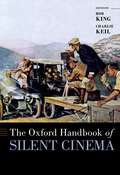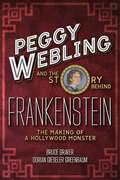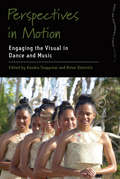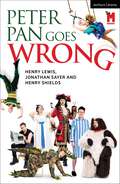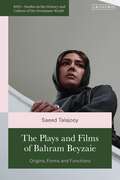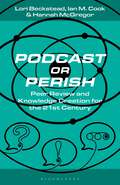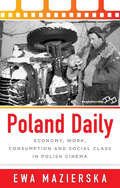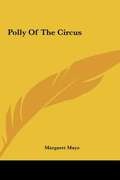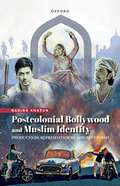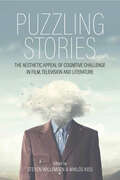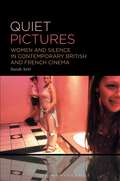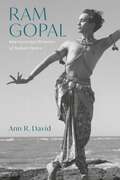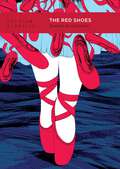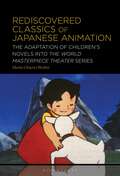- Table View
- List View
The Oxford Handbook of Silent Cinema (Oxford Handbooks)
With thirty-four original chapters from three dozen top scholars, The Oxford Handbook of Silent Cinema provides a thoughtful and provocative re-examination of a medium that would become the dominant form of mass entertainment by the second decade of the twentieth century. The volume is arranged around a series of broad topics: the "invention" of cinema as both technology and medium; the intermedial development of film aesthetics and genres; nontheatrical and non-commercial uses of cinema; the political economy of Hollywood mass culture; film and global modernities; and silent cinema's publics and counter-publics. The historiographical essays in this collection engage with the question of how we might rethink silent film history, especially in the context of the developed media ecosystem that defined the early 1900s. Influenced by methodologies as diverse as media archaeology and industrial studies, and sensitive to both the textual contours of silent films and the cultural, economic, and ideological currents that helped shape them, the Oxford Handbook of Silent Cinema invites its reader to envision its object in expansive terms that incorporate the propulsive energy of the first decades of the 1900s and deploy the analytical frameworks of the current day.
Peeping Tom (Devil's Advocates)
by Kiri WaldenReviled on its release, Peeping Tom (1960) all-but ended the career of director Michael Powell, previously one of Britain's most revered filmmakers. The story of a murderous cameraman and his compulsion to record his killings, Powell's film stunned the same critics who had acclaimed him for the work he'd made with writer-producer Emeric Pressburger (The Life and Death of Colonel Blimp, 1943; A Matter of Life and Death, 1946), resulting in the film falling out of circulation almost as soon as it was released. It took the 1970s 'Movie Brat' generation to rehabilitate the director, and the film, which is now regarded as a masterpiece. In this Devil's Advocate, published to coincide with the film's 60th anniversary, Kiri Walden charts the origins, production and devastating critical reception of Peeping Tom, comparing it to the treatment meted out to its contemporary horror classic, Alfred Hitchcock's Psycho (1960).
Peggy Webling and the Story behind Frankenstein: The Making of a Hollywood Monster
by Peggy Webling Dorian Gieseler Greenbaum Professor Bruce GraverThe 1931 Universal Pictures film adaptation of Frankenstein directed by James Whale and starring Boris Karloff as the now iconic Monster claims in its credits to be 'Adapted from the play by Peggy Webling'. Webling's play sought to humanize the creature, was the first stage adaptation to position Frankenstein and his creation as doppelgängers, and offered a feminist perspective on scientific efforts to create life without women, ideas that suffuse today's perceptions of Frankenstein's monster. The original play script exists in several different versions, only two of which have ever been consulted by scholars; no version has ever been published. Nor have scholars had access to Webling's private papers and correspondence, preserved in a family archive, so that the evolution of Frankenstein from book to stage to screen has never been fully charted. In Peggy Webling and the Story behind Frankenstein, Dorian Gieseler Greenbaum (Webling's great grandniece) and Bruce Graver present the full texts of Webling's unpublished play for the first time. A vital critical edition, this book includes: - the 1927 British Library Frankenstein script used for the first production of the play in Preston, Lancashire - the 1928 Frankenstein script in the Library of Congress, used for productions in UK provincial theatres from autumn 1928 till 1930 - the 1930 Frankenstein Prompt Script for the London production and later provincial performances, held by the Westminster Archive, London - Webling's private correspondence including negotiations with theatre managers and Universal Pictures, family letters about the writing and production process, and selected contracts - Text of the chapter 'Frankenstein' from Webling's unpublished literary memoir, The Story of a Pen for additional context - Biography of Webling that bears directly on the sensibilities and skills she brought to the writing of her play - History of how the play came to be written and produced - The relationship of Webling's play to earlier stage and film adaptations - An exploration of playwright and screenwriter John L. Balderston's changes to Webling's play and Whale's borrowings from it in the 1931 film Offering a new perspective on the genesis of the Frankenstein movie, this critical exploration makes available a unique and necessary 'missing link' in the novel's otherwise well-documented transmedia cultural history.
Perspectives in Motion: Engaging the Visual in Dance and Music (Dance and Performance Studies #15)
by Kendra Stepputat Brian DiettrichFocusing on visual approaches to performance in global cultural contexts, Perspectives in Motion explores the work of Adrienne L. Kaeppler, a pioneering researcher who has made a number of interdisciplinary contributions over five decades to dance and performance studies. Through a diverse range of case studies from Oceania, Asia, and Europe, and interdisciplinary approaches, this edited collection offers new critical and ethnographic frameworks for understanding and experiencing practices of music and dance across the globe.
Pet Sematary (Devil's Advocates)
by Shellie McMurdoMost scholarship on Mary Lambert's Pet Sematary (1989) overarchingly focuses on the Stephen King novel (1983), and tends strongly towards housing the story within the Gothic literary tradition. The film itself is often absent from considerations of North American horror cinema of the 1980s, and from wider horror scholarship in general. This Devil's Advocate stands as a corrective, and provides a holistic analysis – textual, contextual, and industrial – of the film, in order to properly situate it as an important entry into the history of horror cinema. This book joins a growing body of works – both journalistic and academic – that aim to revisit older films in order to call attention to and/or redress the gendered imbalance in our written horror histories. McMurdo charges Pet Sematary with several contributions to the horror genre: as an important entry within the tradition of “grief horror”; as a horror film that both adheres to and defies the generic conventions of its historical context, one both engaged with and respondent to its time of creation; as a film that changed the fortunes of the cinematic Stephen King “brand” on the cusp of a new decade. Pet Sematary is the highest grossing horror film directed by a woman in cinematic history, and it stands as a story that we keep returning to – as seen by the 1992 sequel, the 2019 remake, and a forthcoming prequel. Pet Sematary’s modern relevance and importance to genre history then, is manifold, and this book argues it is past time for its reconsideration as a classic of horror cinema.
Peter Pan Goes Wrong: 2023 West End Edition (Modern Plays)
by Mr Henry Lewis Jonathan Sayer Mr Henry ShieldsIn one of Chris' productions, due to an ill-timed haircut Rapunzel had to be imprisoned in a bungalow. But now with no further ado, please put your hands together for J.M. Barrie's Christmas classic: Peter Pan!The inept and accident-prone Cornley Polytechnic Drama Society set out to present J. M. Barrie's classic tale of Peter Pan, their most audacious production to date. Flying? Pyrotechnics? Sharp hooks? What ensues is two acts of hysterical disaster. You'll laugh, they'll cry. Something so wrong has never been so right.From the mischievous minds of the West End and Edinburgh hit The Play That Goes Wrong comes this highly original, chaos-filled re-telling of J.M. Barrie's much-loved classic.Peter Pan Goes Wrong received its world premiere at the Pleasance Theatre, London, on 10 December 2013 and transferred to the West End on 4 December 2015. The show opened on Broadway on 19 April 2023, and this updated edition was published to coincide with the show returning to the West End for a limited 2023 Christmas season.
The Plays and Films of Bahram Beyzaie: Origins, Forms and Functions (British Institute of Persian Studies)
Bahram Beyzaie is one of Iran's leading playwrights and auteur filmmakers. This book examines several of Beyzaie's films and plays and their preoccupation with the modalities and transformations of Iranian contemporary, historical and mythical identity from different perspectives. The chapters analyse Beyzaie's influential plays such as Arash and So Dies Pahlevan Akbar and his filmic magnum opuses such as The Crow, Bashu, the Little Stranger and Killing Mad Dogs from a range of critical perspectives including ecofeminist, sociopolitical, new-historicist, archetypal and psychoanalytical readings. They also explore Beyzaie's dialogue with filmic genres such as noir, different Iranian languages such as Gilaki, Iranian epics and ritual practices such as ta'ziyeh plays and javanmardi chivalry cults. Together, the chapters show how Beyzaie's works negotiate narratives of belonging and undermine the dominant exclusionist discourses in Iran, and how they use the resources of Iranian folk and performance traditions to comment on the position of women, children, intellectuals, and minorities in society.
Podcast or Perish: Peer Review and Knowledge Creation for the 21st Century (Bloomsbury Podcast Studies)
by Lori Beckstead Ian M. Cook Hannah McGregorPodcasting scholarship is still in its nascent stages. The use of podcasting as a tool for scholarly and intellectual inquiry is a relatively new idea, to think about the medium as an alternative outlet for research output. Podcast or Perish maps out not simply a rationale for the deployment of podcasting as an outlet for open peer review, but also explores some real-world workflows for such a practice.At the forefront of merging these exciting fields, Lori Beckstead, Ian M. Cook, and Hannah McGregor have taken a novel approach to expanding the boundaries of scholarly knowledge by considering podcasting as a focal point for intellectual discussion, engagement, and exploration. By investigating the historical development of the norms of scholarly communication, the unique affordances of sound-based scholarship, and the transformative potential of new modes of knowledge production, Podcast or Perish is the call to action academia needs, by asking how podcasting might change the very ways we think about scholarly work.
Podcasting in a Platform Age: From an Amateur to a Professional Medium (Bloomsbury Podcast Studies)
by John L. SullivanPodcasting in a Platform Age explores the transition underway in podcasting by considering how the influx of legacy and new media interest in the medium is injecting professional and corporate logics into what had been largely an amateur media form. Many of the most high-profile podcasts today, however, are produced by highly-skilled media professionals, some of whom are employees of media corporations. Legacy radio and new media platform giants like Google, Apple, Amazon, and Spotify are also making big (and expensive) moves in the medium by acquiring content producers and hosting platforms. This book focuses on three major aspects of this transformation: formalization, professionalization, and monetization. Through a close read of online and press discourse, analysis of podcasts themselves, participant observations at podcast trade shows and conventions, and interviews with industry professionals and individual podcasters, John Sullivan outlines how the efforts of industry players to transform podcasting into a profitable medium are beginning to challenge the very definition of podcasting itself.
Poland Daily: Economy, Work, Consumption and Social Class in Polish Cinema
by Ewa MazierskaLike many Eastern European countries, Poland has seen a succession of divergent economic and political regimes over the last century, from prewar “embedded liberalism,” through the state socialism of the Soviet era, to the present neoliberal moment. Its cinema has been inflected by these changing historical circumstances, both mirroring and resisting them. This volume is the first to analyze the entirety of the nation’s film history—from the reemergence of an independent Poland in 1918 to the present day—through the lenses of political economy and social class, showing how Polish cinema documented ordinary life while bearing the hallmarks of specific ideologies.
Polly of the Circus
by Margaret MayoThis scarce antiquarian book is a facsimile reprint of the original. Due to its age, it may contain imperfections such as marks, notations, marginalia and flawed pages. Because we believe this work is culturally important, we have made it available as part of our commitment for protecting, preserving, and promoting the world's literature in affordable, high quality, modern editions that are true to the original work.
Poltergeist (Devil's Advocates)
by Rob McLaughlin'Created’ by Steven Spielberg yet officially directed by Tobe Hooper, Poltergeist (1982) can be best described as ‘family horror movie’ both in its target audience and in its narrative context, the story of an All-American suburban family, the Freelings, whose home suddenly becomes the site of a spectacular haunting, apparently summoned by their young daughter. The film is somewhat of an anachronism and this Devil's Advocate explores this in both the scope of production and narrative. The book discusses the duality of the text highlighting debates surrounding both Spielberg's somewhat saccharine portrayal of middle-class Americana and his more subversive cinematic endeavours. The duality of the text also will also be discussed in the context of the film's production – with both Spielberg and Hooper on set for much of the time, the result was a movie with the production values, effects and marketing of a high budget mainstream cinema blockbuster apparently directed by a subversive 'grindhouse' cinema auteur. Yet Poltergeist is neither nor both of those things, instead being a unique hybrid of genres and styles taking the best and worst from both aspects of family blockbuster and cult horror film, and as such can be seen as a text that is something unique – a classic modern take on the traditional haunted house story.
Possession (Devil's Advocates)
by Alison TaylorPremiering at the 1981 Cannes Film Festival, Andrzej Żuławski’s Possession remains a distinct phenomenon. Though in competition for the illustrious Palme d’Or, its art cinema context did not rescue it from being banned as part of the United Kingdom’s ‘video nasties’ campaign, alongside unashamedly lowbrow titles such as Faces of Death and Zombie Flesh Eaters. Skirting the boundary between art and exploitation, body horror and cerebral reverie, relationship drama and political statement, Possession is a truly astonishing film. Part visceral horror, part surreal experiment, part gothic romance dressed in the iconography of a spy thriller: there is no doubt that the polarity evinced by Possession’s initial release was in part a product of its resistance to clear categorisation.With a production history almost as bizarre as the film itself, a cult following gained with its VHS release, and being re-appreciated in the decades since as a valuable work of auteur cinema, the story of how this film came to be is as fascinating as it is unfathomable. Alison Taylor’s Devil’s Advocate considers Possession’s history, stylistic achievement, and legacy as an enduring and unique work of horror cinema. Beginning with a marital breakdown and ending with an apocalypse, the film’s strangeness has not dissipated over time; its transgressive imagery, histrionic performances, and spiral staircase logic remain affective and confounding to critics and fans alike. Respecting the film’s wilfully enigmatic nature, this book helps to unpack its key threads, including the collision between the banal and the horrific, the socio-historical context of its divided Berlin setting, and the significance of its legacy, particularly with regard to the contemporary trend for extreme art horror on the festival circuit.
Postcolonial Bollywood and Muslim Identity: Production, Representation, and Reception
by Dr Nadira KhatunThe book joins a growing scholarship in the field of Bollywood film studies, encompassing methodological sub-groups such as discursive or narrative studies, textual analysis, audience research, and the political economy of Bollywood. It particularly focuses on the representation of Muslims in postcolonial Bollywood cinema that draws upon earlier questions and concerns about narrative style and the politics of representing Muslims. It also includes issues concerning Muslim film genres and the chronological shift in the portrayal of Muslims that is contingent upon national politics. In Bollywood cinema, Muslims have traditionally been portrayed through the lens of religion. Narratives associated with that specific religious identity have been adapted, based on the socio-political setting of the country at the time of the film's making. The study, thus, adds to scholarship on 'representation' in popular Hindi cinema.
Prevenge (Devil's Advocates)
by Andrew GravesPrevenge (2016) is an entertainingly dark 21st-century horror movie detailing the serial killing journey of heavily pregnant Ruth. It’s a cleverly crafted narrative full of stark social commentary, traversing the delicate line between comedy and tragedy by fusing together a kitchen sink approach with a supernatural revenge plot. This book, as part of the Devil’s Advocates series, examines how the film deconstructs the slasher mythology and the sexism therein, and upends stereotypical representations of the ‘weak’ woman and ‘delicate’ mother. With new exclusive input from writer, director and star Alice Lowe, the text also looks at the production’s inception and development, assesses its debts to cult British cinema, and inspects its umbilical connections to Rosemary’s Baby, Alien, Village of the Damned and many other ‘Monstrous Child’ silver screen features.
Puzzling Stories: The Aesthetic Appeal of Cognitive Challenge in Film, Television and Literature
by Steven Willemsen Miklós KissMany films and novels defy our ability to make sense of the plot. While puzzling storytelling, strange incongruities, inviting enigmas and persistent ambiguities have been central to the effects of many literary and cinematic traditions, a great deal of contemporary films and television series bring such qualities to the mainstream—but wherein lies the attractiveness of perplexing works of fiction? This collected volume offers the first comprehensive, multidisciplinary, and trans-medial approach to the question of cognitive challenge in narrative art, bringing together psychological, philosophical, formal-historical, and empirical perspectives from leading scholars across these fields.
Puzzling Stories: The Aesthetic Appeal of Cognitive Challenge in Film, Television and Literature
by Steven Willemsen Miklós KissMany films and novels defy our ability to make sense of the plot. While puzzling storytelling, strange incongruities, inviting enigmas and persistent ambiguities have been central to the effects of many literary and cinematic traditions, a great deal of contemporary films and television series bring such qualities to the mainstream—but wherein lies the attractiveness of perplexing works of fiction? This collected volume offers the first comprehensive, multidisciplinary, and trans-medial approach to the question of cognitive challenge in narrative art, bringing together psychological, philosophical, formal-historical, and empirical perspectives from leading scholars across these fields.
Puzzling Stories: The Aesthetic Appeal of Cognitive Challenge in Film, Television and Literature
by Steven Willemsen Miklós KissMany films and novels defy our ability to make sense of the plot. While puzzling storytelling, strange incongruities, inviting enigmas and persistent ambiguities have been central to the effects of many literary and cinematic traditions, a great deal of contemporary films and television series bring such qualities to the mainstream—but wherein lies the attractiveness of perplexing works of fiction? This collected volume offers the first comprehensive, multidisciplinary, and trans-medial approach to the question of cognitive challenge in narrative art, bringing together psychological, philosophical, formal-historical, and empirical perspectives from leading scholars across these fields.
Quebec Cinema in the 21st Century: Transcending the National (Contemporary French and Francophone Cultures #95)
This collection of ten chapters and three original interviews with Québécois filmmakers focuses on the past two decades of Quebec cinema and takes an in-depth look at a (primarily) Montreal-based filmmaking industry whose increasingly diverse productions continue to resist the hegemony of Hollywood and to exist as a visible and successful hub of French-language – and ever more multilingual – cinema in North America. This volume picks up where Bill Marshall’s 2001 Quebec National Cinema ends to investigate the inherently global nature of Quebec’s film industry and cinematic output since the beginning of the new millennium. Through their analyses of contemporary films (Une colonie, Avant les rues, Bon cop, bad cop, Les Affamés, Tom à la ferme, Uvanga, among others), directors (including Xavier Dolan, Denis Côté, Sophie Desrape, Chloé Robichaud, Jean-Marc Vallée, and Monia Chokri) and genres (such as the buddy comedy and the zombie film), our authors examine the growing tension between Quebec cinema as a “national cinema” and as an art form that reflects the transnationalism of today’s world, a new form of fluidity of individual experiences, and an increasing on-screen presence of Indigenous subjects, both within and outside the borders of the province. The book concludes with specially conducted interviews with filmmakers Denis Chouinard, Bachir Bensadekk, and Marie-Hélène Cousineau, who provide their views and insights on contemporary Quebec filmmaking.
Quiet Pictures: Women and Silence in Contemporary British and French Cinema
by Dr. Sarah ArttQuiet Pictures approaches the films of Joanna Hogg, Lynne Ramsay, Céline Sciamma, and Lucile Hadžhalilovicthrough the lens of silence as a motif and texture.This book takes up the question of different uses of silence in the work of these directors and how this creates a space for foregrounding innovative practices that establish new ways of looking, staring, and gazing. Sarah Artt discusses how the deliberate deployment of silence creates space for the formation of reciprocal gazes that counteract the typically gendered and binary ways in which women and femme-presenting people tend to be portrayed on screen. Quiet Pictures draws on the political legacy of feminist film theory to explore and conceptualise what it means to not just look back, but to share the gaze. This book discusses several films, including: Unrelated (Hogg, 2007), Archipelago (Hogg, 2010), Exhibition (Hogg, 2013), The Souvenir Part I and II (Hogg, 2019 and 2021), Morvern Callar (Ramsay, 2002), We Need to Talk About Kevin (Ramsay, 2011), Innocence (Hadžhalilovic 2004), Evolution (Hadžhalilovic 2015), Waterlilies/Naissance des Pieuvres (Sciamma, 2007), Tomboy (Sciamma, 2011), Girlhood/Bande des Filles (Sciamma, 2014), Portrait of a Lady on Fire/Portrait d'une jeune fille en feu (Sciamma, 2019), and Petite Maman/Little Mother (Sciamma, 2021).
Ram Gopal: Interweaving Histories of Indian Dance
by Ann R. DavidBoth a biography and a history, this book explores the significant role that Indian dancer Ram Gopal (1912-2003) played in bringing Indian dance to international audiences from the 1930s to the late 1960s. Almost single-handedly, Gopal changed the perception of Indian dance abroad, introducing a global audience to specificity of movement, classically trained dancers, live musicians and exquisitely detailed costumes, modelled from Indian iconography. In this much-needed study of an often-neglected figure, the author unearths a fascinating narrative about Ram Gopal, the individual and the dancer, drawing on interviews with his remaining family, costume-makers, friends, dance partners, fellow dancers and audience members. More broadly, we come to understand the culture of Indian dance at the time, including the politics of the nomenclature and of the nationalist and orientalist discourses, the rapid changes created by the demise of colonialism and the influence of Western styles of dance, such as ballet and modern, in its development.
Re-Animator (Devil's Advocates)
by Eddie FalveySince its release at the mid-point of the 1980s American horror boom, Stuart Gordon’s Re-Animator (1985) has endured as one of the most beloved cult horror films of that era. Greeted by enthusiastic early reviews, Re-Animator has maintained a spot at the periphery of the classic horror film canon. While Re-Animator has not entirely gone without critical attention, it has often been overshadowed in horror studies by more familiar titles from the period. Eddie Falvey’s book, which represents the first book-length study of Re-Animator, repositions it as one of the most significant American horror films of its era. For Falvey, Re-Animator sits at the intersection of various developments that were taking place within the context of 1980s American horror production. He uses Re-Animator to explore the rise and fall of Charles Band’s Empire Pictures, the revival of the mad science sub-genre, the emergent popularity of both gore aesthetics and horror-comedies, as well as a new appetite for the works of H.P. Lovecraft in adaptation. Falvey also tracks the film's legacies, observing not only how Re-Animator’s success gave rise to a new Lovecraftian cycle fronted by Stuart Gordon, but also how its cult status has continued to grow, marked by sequels, spin-offs, parodies and re-releases. As such, Falvey's book promises to be a book both about Re-Animator itself and about the various contexts that birthed it and continue to reflect its influence.
The Red Shoes (BFI Film Classics)
by Pamela HutchinsonEndlessly fascinating, dark and bright, The Red Shoes (1948) employs every branch of the cinematic arts to sweep the audience off its feet, invigorated by the transcendence of art itself, only to leave them with troubling questions. Representing the climax of Michael Powell and Emeric Pressburger's celebrated run of six exceptional feature films, the film remains a beloved, if unsettling and often divisive, classic.Pamela Hutchinson's study of the film examines its breathtaking use of Technicolor, music, choreography, editing and art direction at the zenith of Powell and Pressburger's capacity for 'composed cinema'. Through a close reading of key scenes, particularly the film's famous extended ballet sequence, she considers the unconventional use of ballet as uncanny spectacle and the feminist implications of the central story of female sacrifice.Hutchinson goes on to consider the film's lasting and wide-reaching influence, tracing its impact on the film musical genre and horror cinema, with filmmakers such as Joanna Hogg, Sally Potter, Martin Scorsese and Brian De Palma having cited the film as an inspiration.
Rediscovered Classics of Japanese Animation: The Adaptation of Children’s Novels into the World Masterpiece Theater Series
by Maria Chiara OltoliniRediscovered Classics of Japanese Animation is the first academic work to examine World Masterpiece Theater (Sekai Meisaku Gekijô, 1969-2009), which popularized the practice of adapting foreign children's books into long-running animated series and laid the groundwork for powerhouses like Studio Ghibli.World Masterpiece Theater (Sekai Meisaku Gekijô, 1969-2009) is a TV staple created by the Japanese studio Nippon Animation, which popularized the practice of adapting foreign children's books into long-running animated series. Once generally dismissed by critics, the series is now frequently investigated as a key early work of legendary animators Isao Takahata and Hayao Miyazaki. In the first book-length examination of the series, Maria Chiara Olitini analyzes cultural significance of World Masterpiece Theater, and the ways in which the series pioneered the importance of children's fiction for Japanese animation studios and laid the groundwork for powerhouses like Studio Ghibli.Adapting a novel for animation also means decoding (and re-coding) socio-cultural patterns embedded in a narrative. World Masterpiece Theater stands as a unique example of this linguistic, medial, and cultural hybridisation. Popular children's classics such as Little Women, Peter Pan, and Anne of Green Gables became the starting point of a full-fledged negotiation process in which Japanese animators retold a whole range of narratives that have one basic formula in common: archetypal stories with an educational purpose. In particular, the series played a role in shaping the pop culture image of a young girl (shôjo).Examining the series through the lens of animation studies as well as adaptation studies, Olitini sheds new light on this long-neglected staple of Japanese animation history.
Reimagining the Italian South: Migration, Translation and Subjectivity in Contemporary Italian Literature and Cinema (Transnational Italian Cultures #6)
by Goffredo PolizziImages of southern Italy as a place of arrival for migrants with different origins and backgrounds have in recent years proliferated in Italian media as well as in contemporary Italian literature and cinema. The unprecedented perspective which presents the mezzogiorno as a place where people arrive, and not only as a place of departure, constitutes a major change in the collective imaginary on the region and fosters new engagements with its migratory histories. This book presents one of the first studies to focus entirely, through in-depth readings of a range of contemporary literary and cinematic texts, on the representation of contemporary migration to southern Italy, and on the concomitant changes in the tradition of representation of the region. Informed by translation theory, and by decolonial, queer and feminist critique, this innovative study zeroes in on the mutual construction of race, gender and sexuality, and on the translation and hybridization of languages and cultures at the southern border. By giving a rich and compelling account of texts which tell multiple stories of mobility from, to and through the South, this book traces the emergence of a transnational imaginary of the mezzogiorno which offers useful tools for an urgent reconfiguration of collective and individual identities.
